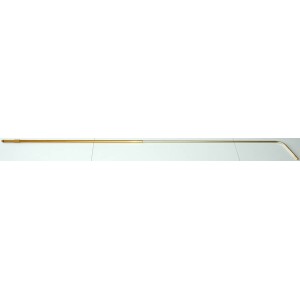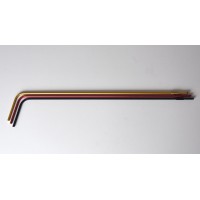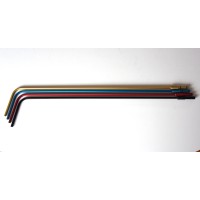Total Energy Probe, Long, Tail Mount
Total energy probe to be mounted to tail of the glider pointing forward.
Diameter of base that fits into the mount: 8 mm
Diameter of collar near base: 10 mm
Diameter of part of probe near base: 8 mm
Diameter of part of probe near bent tip: 6 mm
Length: 900 mm (35.4")
Length of part that fits into 8 mm hole: 28 mm (1.10")
The slots for the 2 o-rings are located from about 3 to 5 and 22 to 24 mm from the end of the probe.
Color Options:
- Gold
- Blue
These are the very famous ILEC TE probes. Due to the special design of these probes, they offer excellent compensation combined with high insensitivity to sideslip. This feature of the TE-probe is especially important during thermalling, where a small sideslip is nearly unavoidable. The use of TE-Probes for total energy compensation is superior to the usage of membrane systems or electronically compensation, because the latter two methods strongly depend on the accurate measurement of the static pressure. Static measurement is in nearly all aircraft a serious (unsolved) problem, especially in case of sideslip.
ILEC Probes are made out of a very durable aluminum alloy with a golden galvanized surface to protect against corrosion. Due to the low weight, the tendency of our probe to oscillate is less compared to brass or steel probes. Each probe consists of three parts: the sensing head with its two holes, the tube and the mount with O-ring sealing. The probe is simply installed by pushing it into the opening. The O-ring seals, putting tape around the mount is not necessary. After landing, the probe is pulled out and stored at a safe place.
Maintenance of the Probe
It is recomended to grease the connector slightly, e.g. with Vaseline© Before insertion of the probe make sure the edge of the assembly adaptor is rounded. Otherwise the O-ring easily can be cut and destroyed.
Assembly Note
"For easier transport, extended probes are sent in two parts, and must be assembled by the customer, by bonding. Put a thin coat of epoxy adhesive (araldite or equivalent), or cyanoacrylate on the end of the this tube. Mate it with the extender tube, and push them together. Wait for curing. Ready. Attention, do not clog the tube by using too much adhesive. Bonding surfaces must be clean. In necessary, clean with organic solvent (Tetra, Tri, or equivalent). WARNING! Experience shows that with tubes which have not been bonded, the front tube will come loose mostly during takeoff under the influence of shocks to the tail. Consequently it will be lost here, or during the flight. This is not only regrettable but may be dangerous. Where - for any reason whatsoever - the tubes are not being bonded, a wide and tough adhesive tape must be wound around the joint, as a minimum, for safety."
Assembly Instructions for Long ILEC TE Probes
Total Energy Compensation In Practice - Brozel
Note from Cumulus Soaring
The use of tape as a back-up is a good idea if the glue bond is not good for safety purposes of course, but the use of tape alone will probably not provide an adequate seal for good performance of the TE probe. Small leaks are a big problem with TE systems.
Related Products
ILEC-TE-Tail-6mm
Total Energy Probe, Tail Mount, 6mmTotal energy probe to be mounted to tail of the glider pointing f..
$90.00
ILEC-TE-Tail-8mm
Total Energy Probe, Tail Mount, 8mmTotal energy probe to be mounted to tail of the glider pointing f..
$90.00
Tags: probe







